Direction of Arrival Estimation Based on Received Signal Strength Using Two-Row Electronically Steerable Parasitic Array Radiator Antenna
Abstract
:1. Introduction
- In-depth analysis of the antenna from the connectivity perspective with respect to possible beam steering in horizontal and elevation directions;
- Presentation of an approach for DoA estimation relying solely on RSS values gathered at the antenna output, which is a prerequisite for energy-efficient WSN nodes having DoA functionality [9,10], that is suitable for the antenna and can provide acceptable DoA estimation results also for low θ angles and are free from ambiguities for lower SNR values;
- Proposal of a detailed DoA algorithm performance testing method for more accurate DoA estimation accuracy assessment that involves all θ angles to address strong error variation at low θ angles.
2. Two-Row ESPAR Antenna
2.1. Antenna Design
2.2. Realized Antenna
2.3. Antenna Radiation Performance Analysis
3. RSS-Based DoA Estimation for Two-Row ESPAR Antenna
3.1. PPCC-MCP Algorithm
3.2. Generalized PPCC-MCP Algorithm for Two-Row ESPAR Antenna
4. Results and Discussion
4.1. Mesurement Setup
4.2. Deatiled DoA Testing Method
4.3. DoA Estimation Results
5. Conclusions
Author Contributions
Funding
Institutional Review Board Statement
Informed Consent Statement
Data Availability Statement
Conflicts of Interest
References
- Zanella, A.; Bui, N.; Castellani, A.; Vangelista, L.; Zorzi, M. Internet of things for smart cities. IEEE Internet Things J. 2014, 1, 22–32. [Google Scholar] [CrossRef]
- Sotres, P.; Santana, J.R.; Sanchez, L.; Lanza, J.; Munoz, L. Practical lessons from the deployment and management of a smart city internet-of-things infrastructure: The SmartSantander Testbed Case. IEEE Access 2017, 5, 14309–14322. [Google Scholar] [CrossRef]
- Low, K.S.; Win, W.N.N.; Er, M.J. Wireless Sensor Networks for industrial environments. In Proceedings of the International Conference on Computational Intelligence for Modelling, Control and Automation and International Conference on Intelligent Agents, Web Technologies and Internet Commerce (CIMCA-IAWTIC’06), Vienna, Austria, 28–30 November 2005; pp. 271–276. [Google Scholar] [CrossRef]
- Joshi, G.P.; Nam, S.Y.; Kim, S.W. Cognitive radio Wireless Sensor Networks: Applications, challenges and research trends. Sensors 2013, 13, 11196–11228. [Google Scholar] [CrossRef] [PubMed] [Green Version]
- Al-Karaki, J.N.; Gawanmeh, A. The optimal deployment, coverage, and connectivity problems in Wireless Sensor Networks: Revisited. IEEE Access 2017, 5, 18051–18065. [Google Scholar] [CrossRef]
- Tran, T.; An, M.K.; Huynh, D.T. Symmetric connectivity in WSNs equipped with multiple directional antennas. In Proceedings of the 2017 International Conference on Computing, Networking and Communications (ICNC), Silicon Valley, CA, USA, 26–29 January 2017; pp. 609–614. [Google Scholar]
- Brás, L.; Carvalho, N.B.; Pinho, P.; Kulas, L.; Nyka, K. A review of antennas for indoor positioning systems. Int. J. Antennas Propag. 2012, 2012, 1–14. [Google Scholar] [CrossRef]
- Curiac, D.-I. Wireless Sensor Network security enhancement using directional antennas: State of the art and research challenges. Sensors 2016, 16, 488. [Google Scholar] [CrossRef] [Green Version]
- Catarinucci, L.; Guglielmi, S.; Colella, R.; Tarricone, L. Compact switched-beam antennas enabling novel power-efficient Wireless Sensor Networks. IEEE Sens. J. 2014, 14, 3252–3259. [Google Scholar] [CrossRef]
- Groth, M.; Rzymowski, M.; Nyka, K.; Kulas, L. ESPAR antenna-based WSN node with DoA estimation capability. IEEE Access 2020, 8, 91435–91447. [Google Scholar] [CrossRef]
- Lysko, A.A. Towards an ultra-low-power electronically controllable array antenna for WSN. In Proceedings of the 2012 IEEE-APS Topical Conference on Antennas and Propagation in Wireless Communications (APWC), Cape Town, South Africa, 2–7 September 2012; pp. 642–645. [Google Scholar]
- Loh, T.; Liu, K.; Qin, F.; Liu, H. Assessment of the adaptive routing performance of a Wireless Sensor Network using smart antennas. IET Wirel. Sens. Syst. 2014, 4, 196–205. [Google Scholar] [CrossRef]
- Viani, F.; Lizzi, L.; Donelli, M.; Pregnolato, D.; Oliveri, G.; Massa, A. Exploitation of parasitic smart antennas in Wireless Sensor Networks. J. Electromagn. Waves Appl. 2010, 24, 993–1003. [Google Scholar] [CrossRef] [Green Version]
- Skiani, E.D.; Mitilineos, S.A.; Thomopoulos, S.C.A. A study of the performance of Wireless Sensor Networks operating with smart antennas. IEEE Antennas Propag. Mag. 2012, 54, 50–67. [Google Scholar] [CrossRef]
- Ademaj, F.; Rzymowski, M.; Bernhard, H.-P.; Nyka, K.; Kulas, L. Relay-aided Wireless Sensor Network discovery algorithm for dense industrial IoT utilizing ESPAR antennas. IEEE Internet Things J. 2021, 8, 16653–16665. [Google Scholar] [CrossRef]
- Groth, M.; Nyka, K.; Kulas, L. Calibration-free single-anchor indoor localization using an ESPAR antenna. Sensors 2021, 21, 3431. [Google Scholar] [CrossRef] [PubMed]
- Harrington, R. Reactively controlled directive arrays. IEEE Trans. Antennas Propag. 1978, 26, 390–395. [Google Scholar] [CrossRef]
- Taillefer, E.; Hirata, A.; Ohira, T. Direction-of-arrival estimation using radiation power pattern with an ESPAR antenna. IEEE Trans. Antennas Propag. 2005, 53, 678–684. [Google Scholar] [CrossRef]
- Kulas, L. RSS-based DoA estimation using ESPAR antennas and interpolated radiation patterns. IEEE Antennas Wirel. Propag. Lett. 2018, 17, 25–28. [Google Scholar] [CrossRef]
- Plotka, M.; Tarkowski, M.; Nyka, K.; Kulas, L. A novel calibration method for RSS-based DoA estimation using ESPAR antennas. In Proceedings of the 22nd International Microwave and Radar Conference (MIKON), Poznan, Poland, 14–17 May 2018; pp. 65–68. [Google Scholar]
- Asif, M.; Khan, S.; Ahmad, R.; Sohail, M.; Singh, D. Quality of service of routing protocols in Wireless Sensor Networks: A review. IEEE Access 2017, 5, 1846–1871. [Google Scholar] [CrossRef]
- Shen, J.; Wang, A.; Wang, C.; Hung, P.C.K.; Lai, C.-F. An efficient centroid-based routing protocol for energy management in WSN-assisted IoT. IEEE Access 2017, 5, 18469–18479. [Google Scholar] [CrossRef]
- Rzymowski, M.; Kulas, L. RSS-based direction-of-arrival estimation with increased accuracy for arbitrary elevation angles using ESPAR antennas. In Proceedings of the 12th European Conference on Antennas and Propagation (EuCAP 2018), London, UK, 9–13 April 2018; pp. 1–4. [Google Scholar] [CrossRef]
- Groth, M.; Kulas, L. Accurate PPCC-based DoA estimation using multiple calibration planes for WSN nodes equipped with ESPAR antennas. In Proceedings of the 2018 48th European Microwave Conference (EuMC), Madrid, Spain, 23–27 September 2018; pp. 1565–1568. [Google Scholar] [CrossRef]
- Cremer, M.; Dettmar, U.; Hudasch, C.; Kronberger, R.; Lerche, R.; Pervez, A. Localization of passive UHF RFID tags using the AoAct transmitter beamforming technique. IEEE Sens. J. 2015, 16, 1762–1771. [Google Scholar] [CrossRef]
- Huang, S.; Gan, O.P.; Jose, S.; Li, M. Localization for industrial warehouse storage rack using passive UHF RFID system. In Proceedings of the 2017 22nd IEEE International Conference on Emerging Technologies and Factory Automation (ETFA), Limassol, Cyprus, 12–15 September 2017; pp. 1–8. [Google Scholar] [CrossRef]
- Kulas, L. Simple 2-D direction-of-arrival estimation using an ESPAR antenna. IEEE Antennas Wirel. Propag. Lett. 2017, 16, 2513–2516. [Google Scholar] [CrossRef]
- Burtowy, M.; Rzymowski, M.; Kulas, L. Low-profile ESPAR antenna for RSS-based DoA estimation in IoT applications. IEEE Access 2019, 7, 17403–17411. [Google Scholar] [CrossRef]
- Buffi, A.; Nepa, P.; Cioni, R. SARFID on drone: Drone-based UHF-RFID tag localization. In Proceedings of the 2017 IEEE International Conference on RFID Technology & Application (RFID-TA), Warsaw, Poland, 20–22 September 2017; pp. 40–44. [Google Scholar] [CrossRef]
- De Oliveira, M.T.; Miranda, R.K.; Da Costa, J.P.C.L.; De Almeida, A.L.F.; De Sousa, R.T. Low cost antenna array based drone tracking device for outdoor environments. Wirel. Commun. Mob. Comput. 2019, 2019, 5437908. [Google Scholar] [CrossRef]
- Rzymowski, M.; Kulas, L. Two-row ESPAR antenna with simple elevation and Azimuth Beam Switching. IEEE Antennas Wirel. Propag. Lett. 2021, 20, 1745–1749. [Google Scholar] [CrossRef]
- Duraj, D.; Rzymowski, M.; Nyka, K.; Kulas, L. ESPAR antenna for V2X applications in 802.11p frequency band. In Proceedings of the 2019 13th European Conference on Antennas and Propagation (EuCAP), Krakow, Poland, 31 March–5 April 2019; pp. 1–4. [Google Scholar]
- Duraj, D.; Tarkowski, M.; Rzymowski, M.; Kulas, L.; Nyka, K. RSS-based DoA estimation in 802.11p frequency band using ESPAR antenna and PPCC-MCP method. In Proceedings of the 2020 23rd International Microwave and Radar Conference (MIKON), Warsaw, Poland, 5–8 October 2020; pp. 15–156. [Google Scholar] [CrossRef]
- Lin, Z.; Lin, M.; de Cola, T.; Wang, J.-B.; Zhu, W.-P.; Cheng, J. Supporting IoT with rate-splitting multiple access in satellite and aerial-integrated networks. IEEE Internet Things J. 2021, 8, 11123–11134. [Google Scholar] [CrossRef]
- Lin, Z.; Lin, M.; Zhu, W.-P.; Wang, J.-B.; Cheng, J. Robust secure beamforming for wireless powered cognitive satellite-terrestrial networks. IEEE Trans. Cogn. Commun. Netw. 2020, 7, 567–580. [Google Scholar] [CrossRef]
- Lin, Z.; Lin, M.; Champagne, B.; Zhu, W.-P.; Al-Dhahir, N. Secure beamforming for cognitive satellite terrestrial networks with unknown eavesdroppers. IEEE Syst. J. 2020, 15, 2186–2189. [Google Scholar] [CrossRef]
- Lin, Z.; Lin, M.; Wang, J.-B.; De Cola, T.; Wang, J. Joint beamforming and power allocation for satellite-terrestrial integrated networks with non-orthogonal multiple access. IEEE J. Sel. Top. Signal Process. 2019, 13, 657–670. [Google Scholar] [CrossRef] [Green Version]
- Rahmat-Samii, Y.; Manohar, V.; Kovitz, J.M. For Satellites, Think Small, Dream Big: A review of recent antenna developments for CubeSats. IEEE Antennas Propag. Mag. 2017, 59, 22–30. [Google Scholar] [CrossRef]
- Sugiura, S.; Iizuka, H. Reactively steered ring antenna array for automotive application. IEEE Trans. Antennas Propag. 2007, 55, 1902–1908. [Google Scholar] [CrossRef]
- Zhang, L.; Gao, S.; Luo, Q.; Young, P.R.; Li, Q. Planar ultrathin small beam-switching antenna. IEEE Trans. Antennas Propag. 2016, 64, 5054–5063. [Google Scholar] [CrossRef]
- Xu, B.; Ying, Z.; Scialacqua, L.; Scannavini, A.; Foged, L.J.; Bolin, T.; Zhao, K.; He, S.; Gustafsson, M. Radiation performance analysis of 28 GHz antennas integrated in 5G mobile terminal housing. IEEE Access 2018, 6, 48088–48101. [Google Scholar] [CrossRef]
- Hazmi, A.; Tian, R.; Rintamaki, S.; Milosavljevic, Z.; Ilvonen, J.; Van Wonterghem, J.; Khripkov, A.; Kamyshev, T. Spherical coverage characterization of millimeter wave antenna arrays in 5G mobile terminals. In Proceedings of the 2019 13th European Conference on Antennas and Propagation (EuCAP), Krakow, Poland, 31 March–5 April 2019; pp. 1–5. [Google Scholar]
- Groth, M.; Leszkowska, L.; Kulas, L. Efficient RSS-based DoA estimation for ESPAR antennas using multiplane SDR calibration approach. In Proceedings of the 2018 IEEE-APS Topical Conference on Antennas and Propagation in Wireless Communications (APWC), Cartagena, Colombia, 10–14 September 2018; pp. 850–853. [Google Scholar] [CrossRef]
- Das, U.; Boer, H.J.; Van Ardenne, A. Phased array technology for GPR antenna design for near subsurface exploration. In Proceedings of the 2nd International Workshop onAdvanced Ground Penetrating Radar, Delft, The Netherlands, 14–16 May 2003; pp. 30–35. [Google Scholar] [CrossRef]
- Salucci, M.; Gelmini, A.; Vrba, J.; Merunka, I.; Oliveri, G.; Rocca, P. Instantaneous brain stroke classification and localization from real scattering data. Microw. Opt. Technol. Lett. 2018, 61, 805–808. [Google Scholar] [CrossRef]
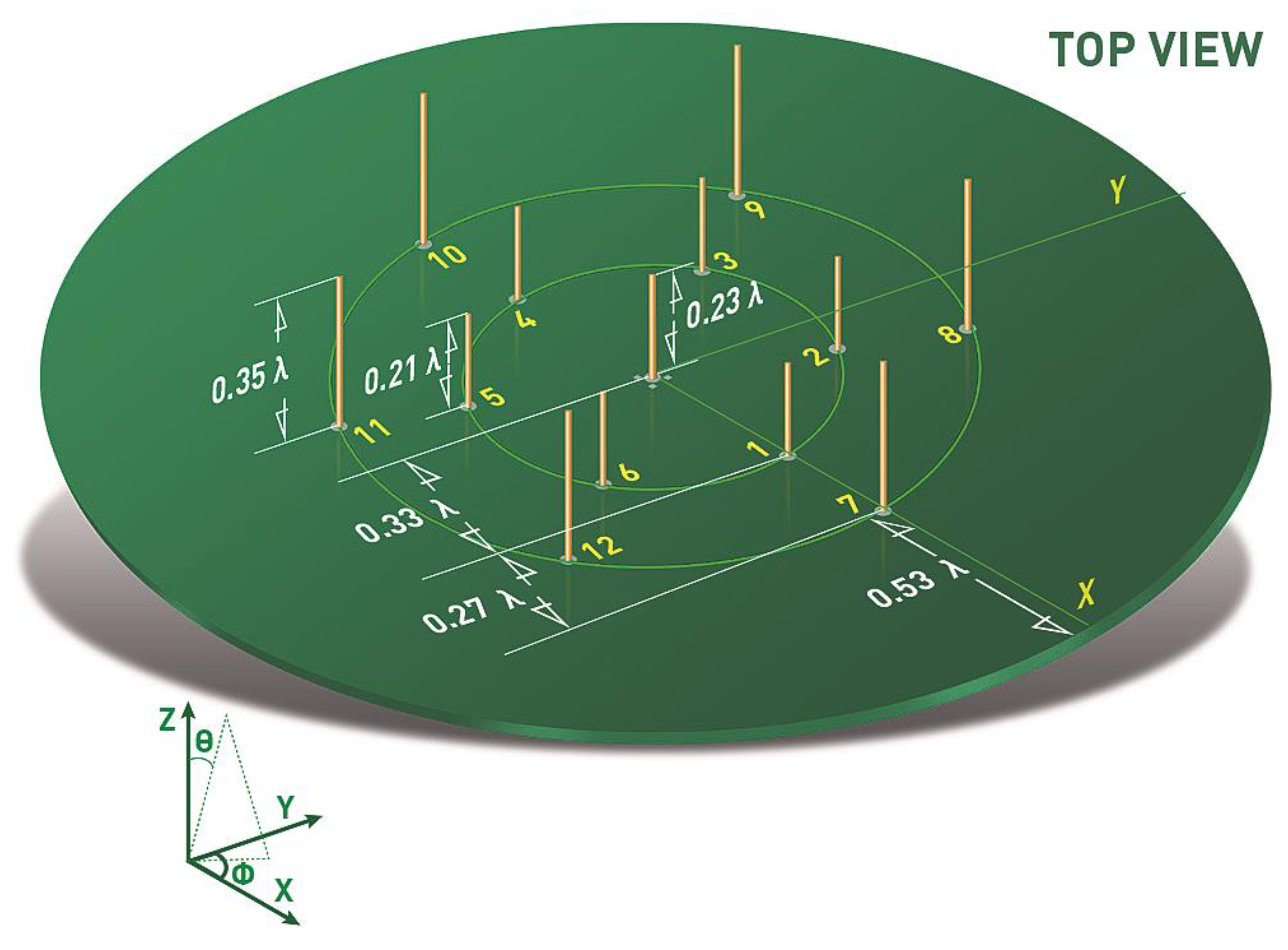
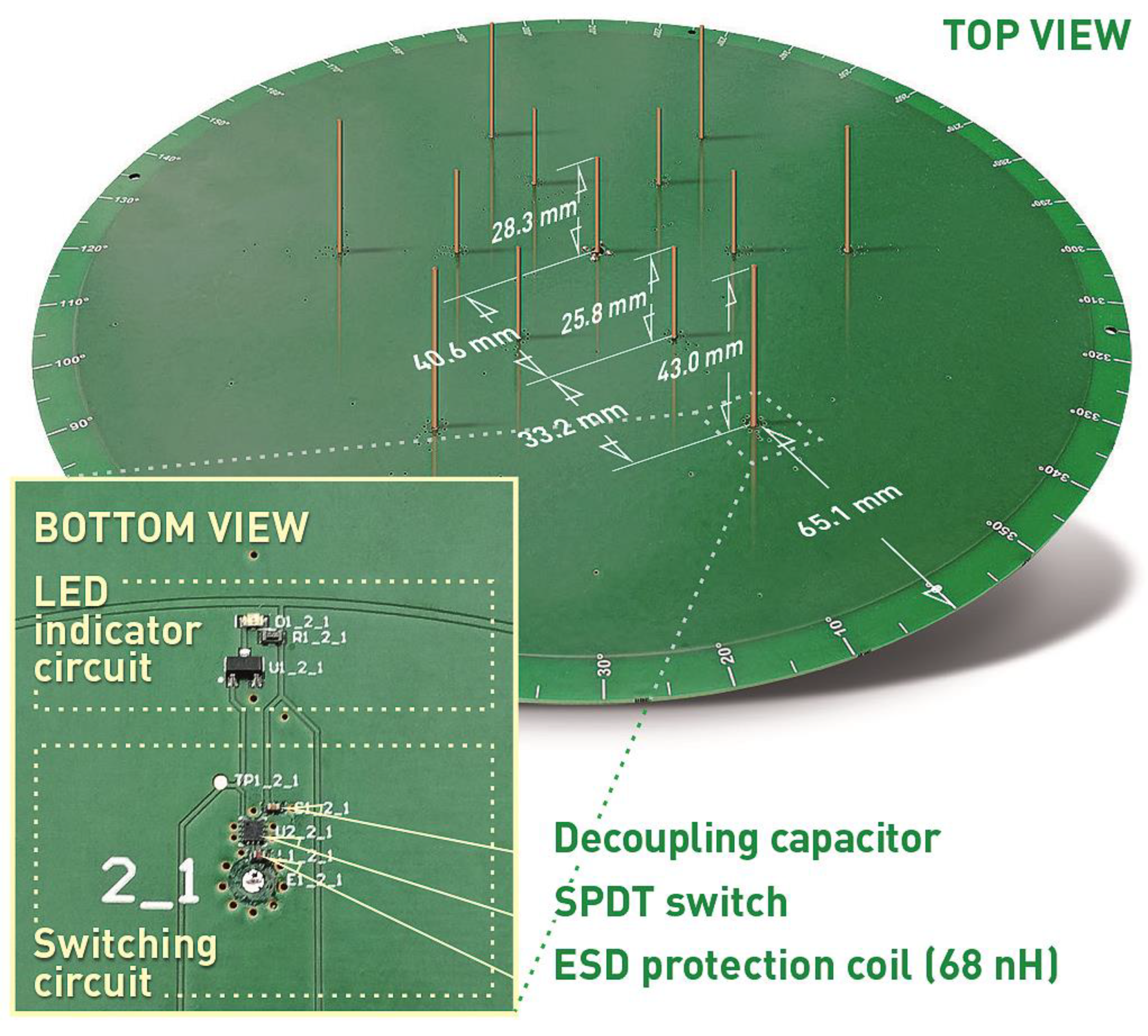
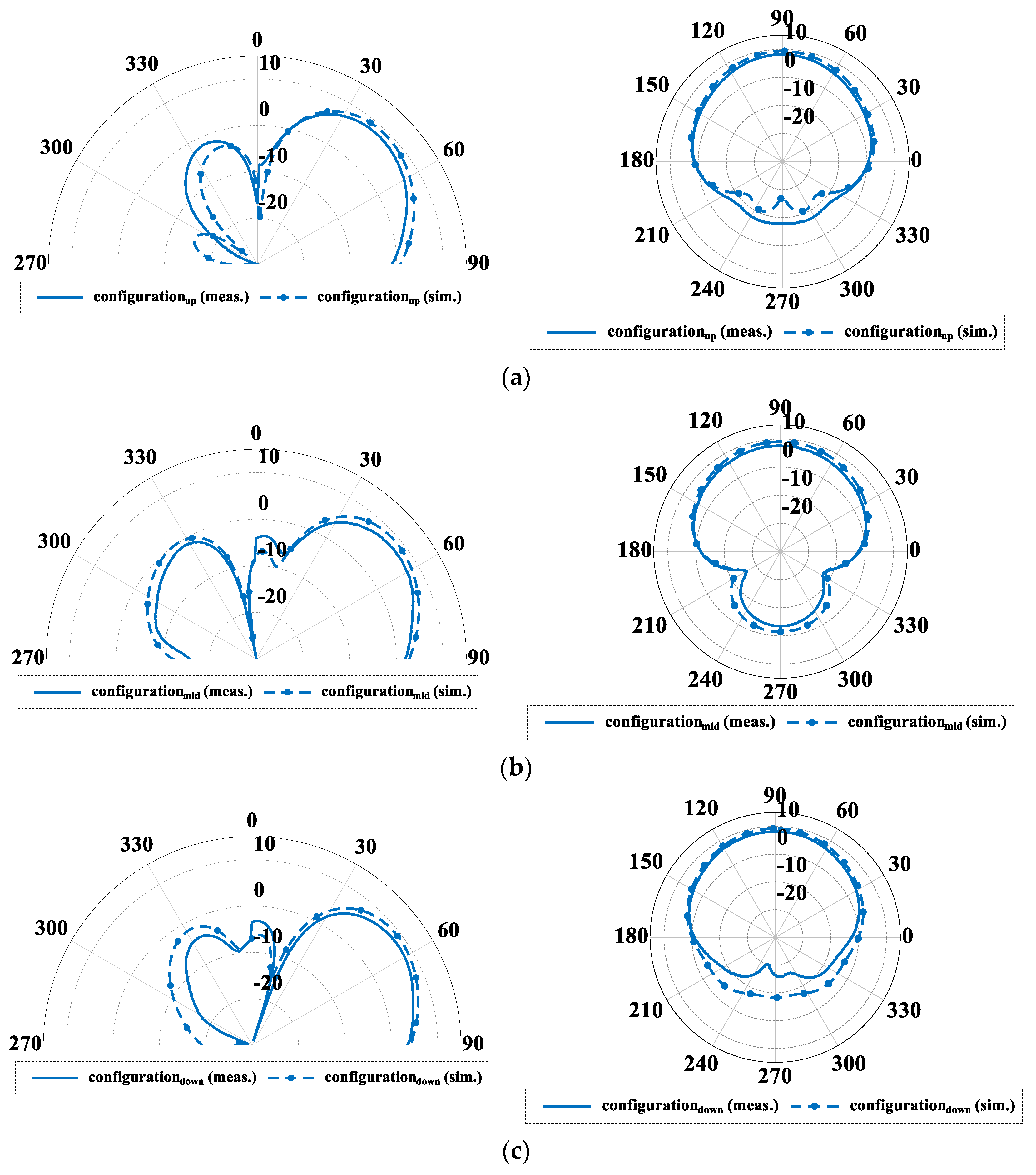


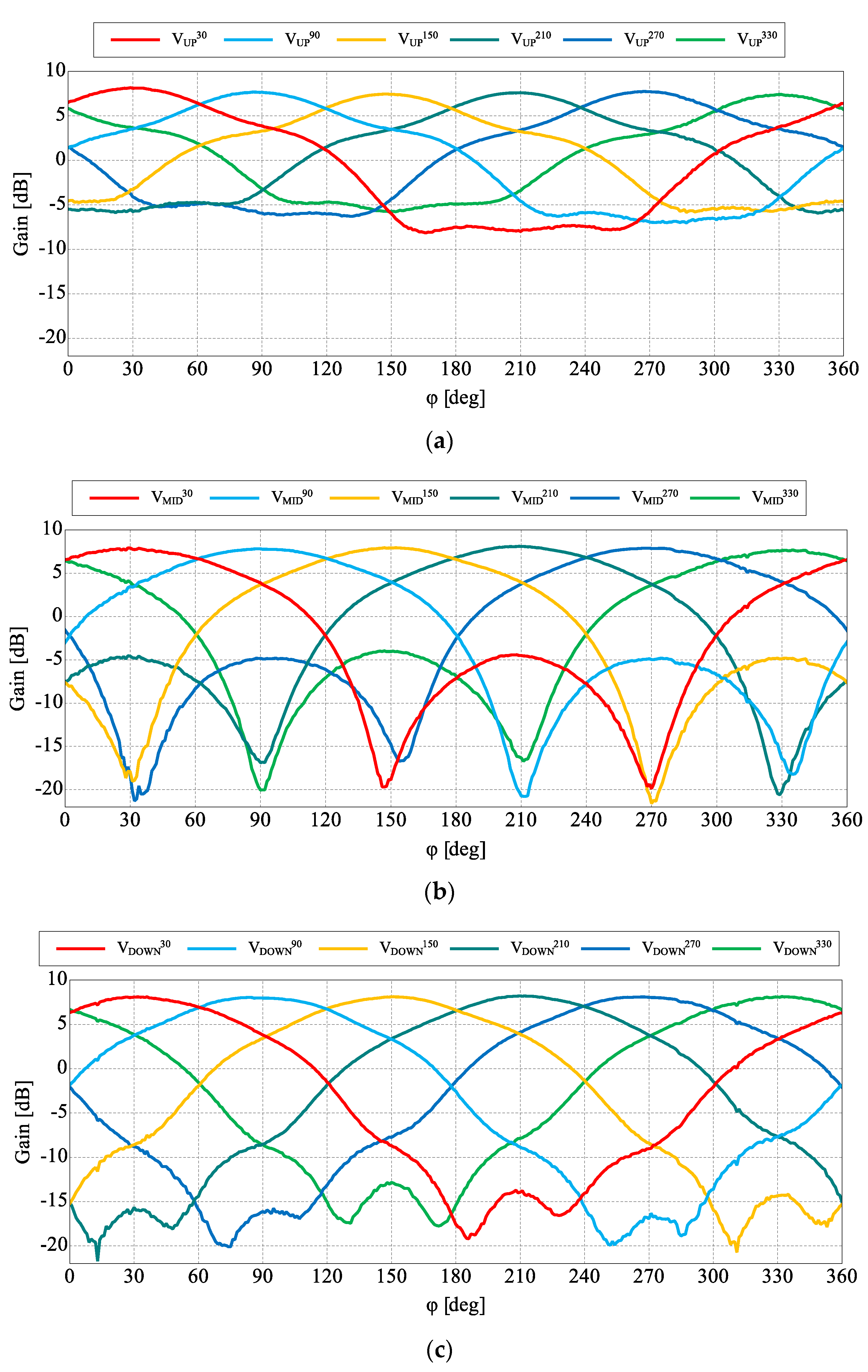
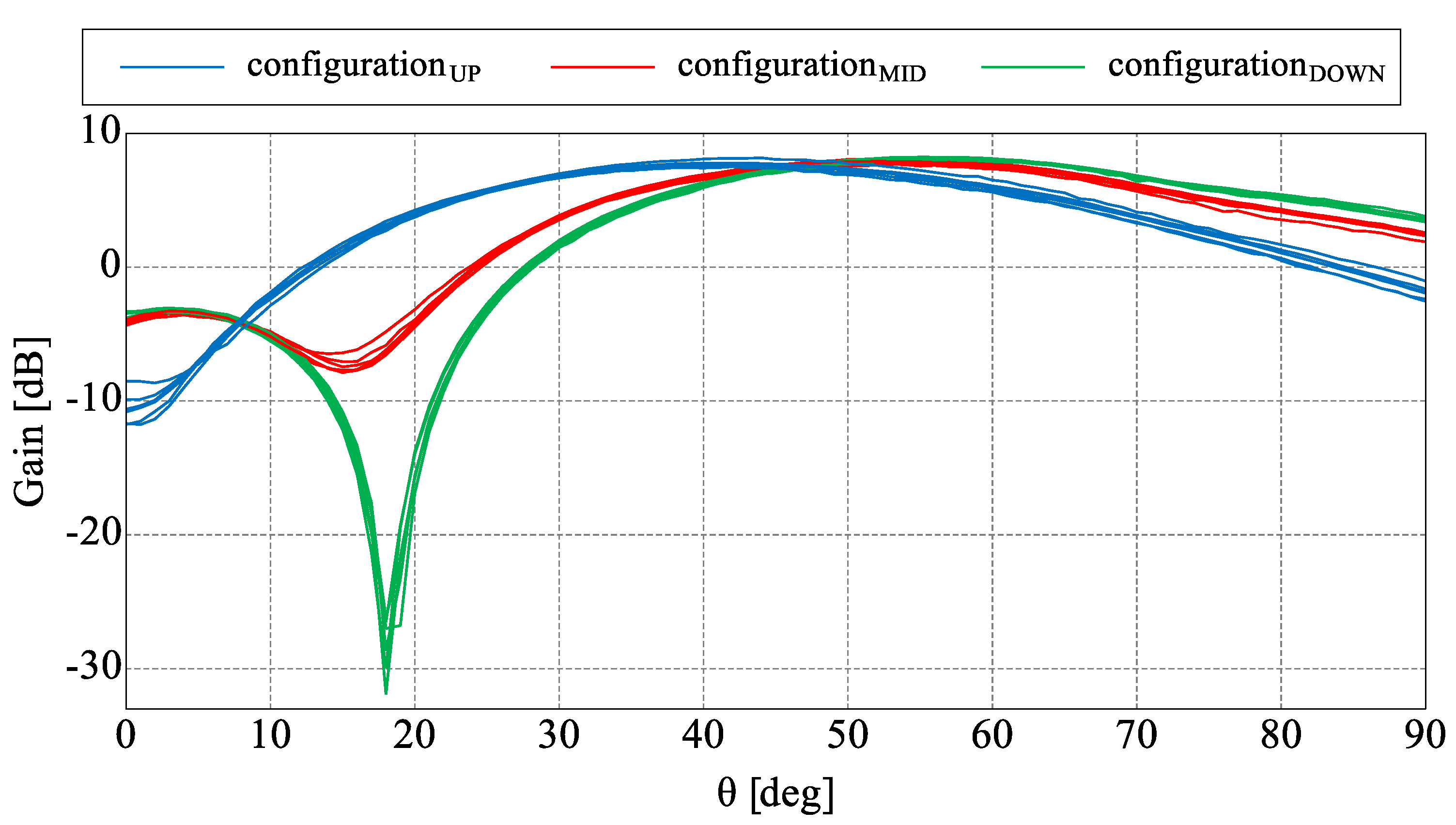

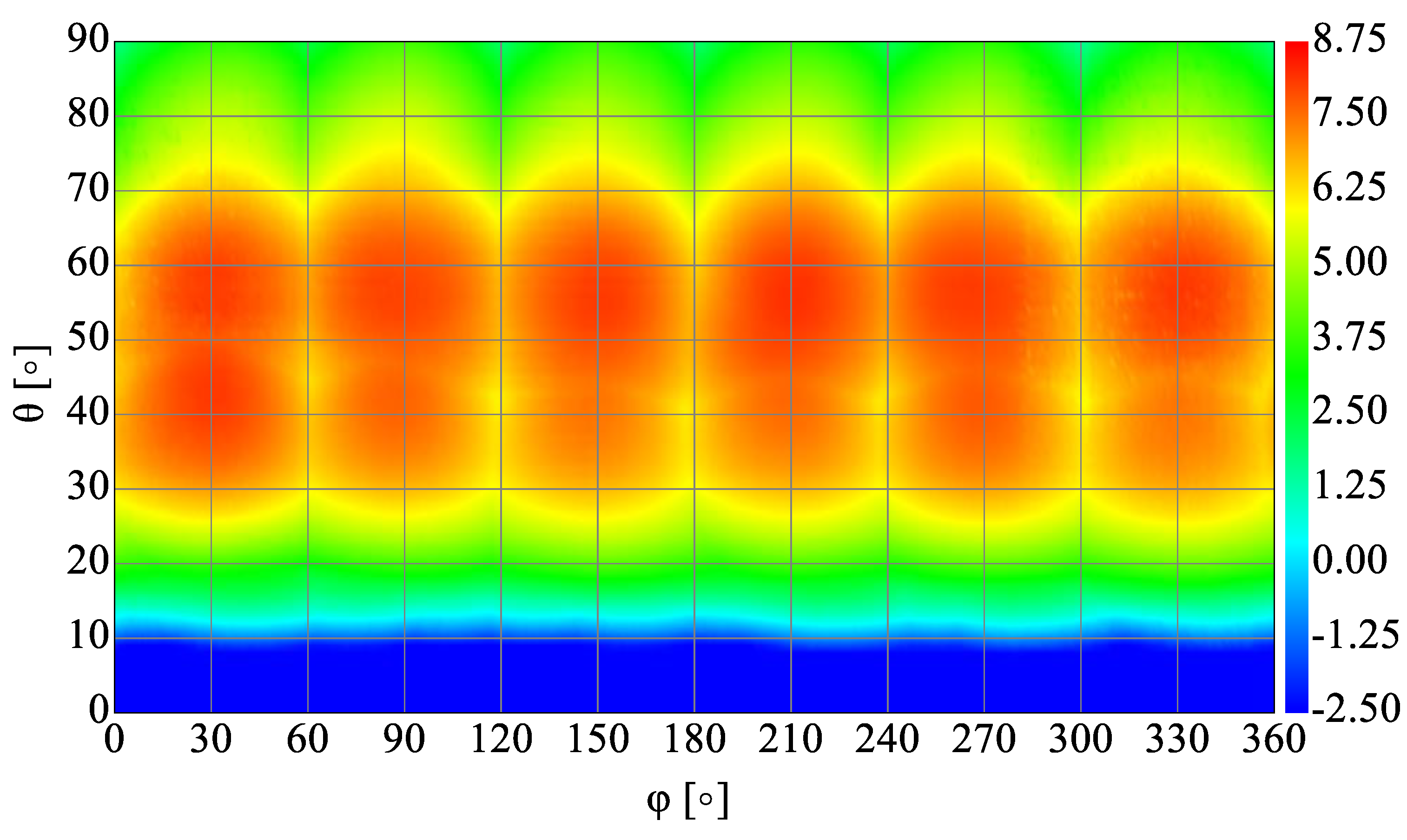

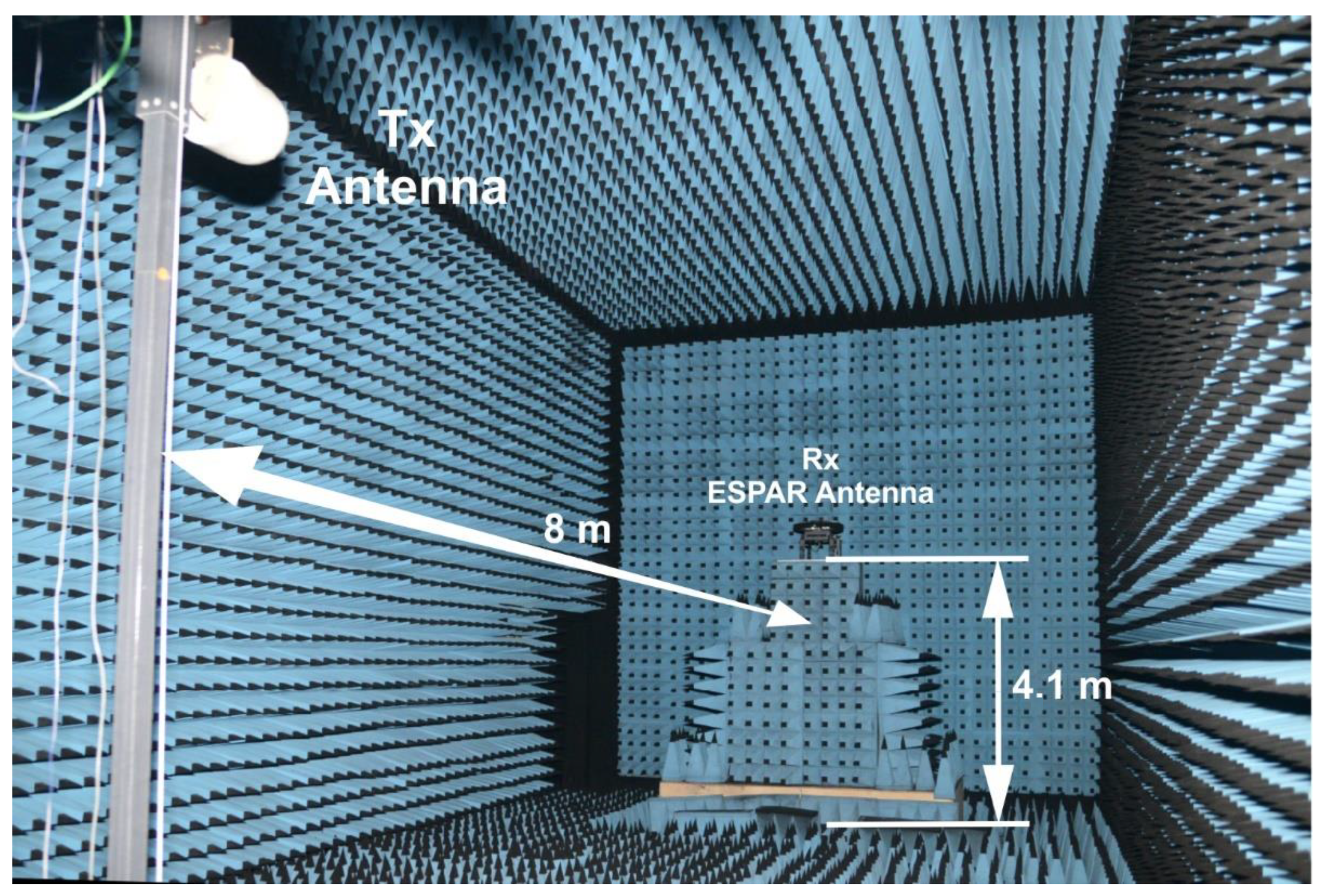
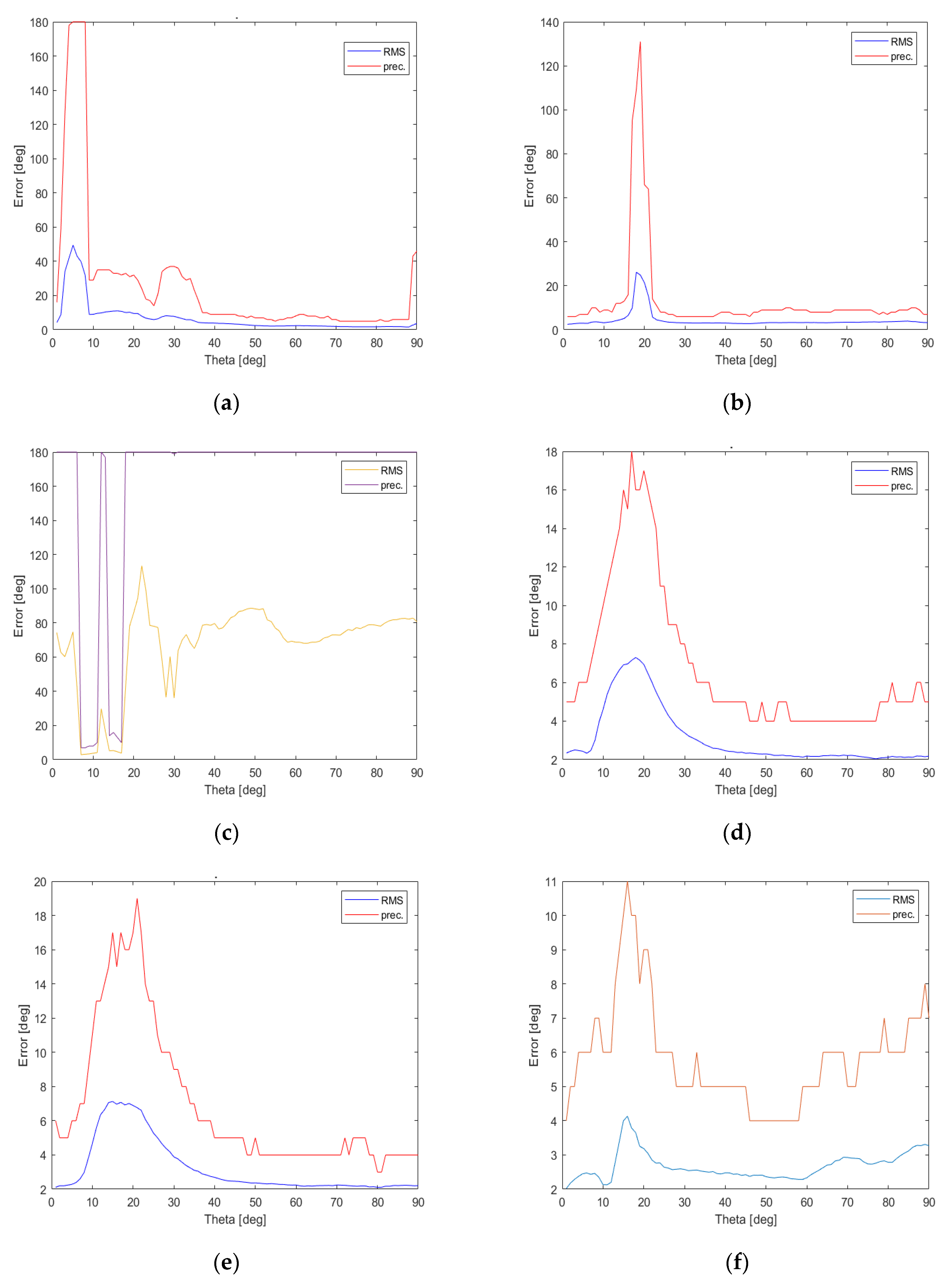
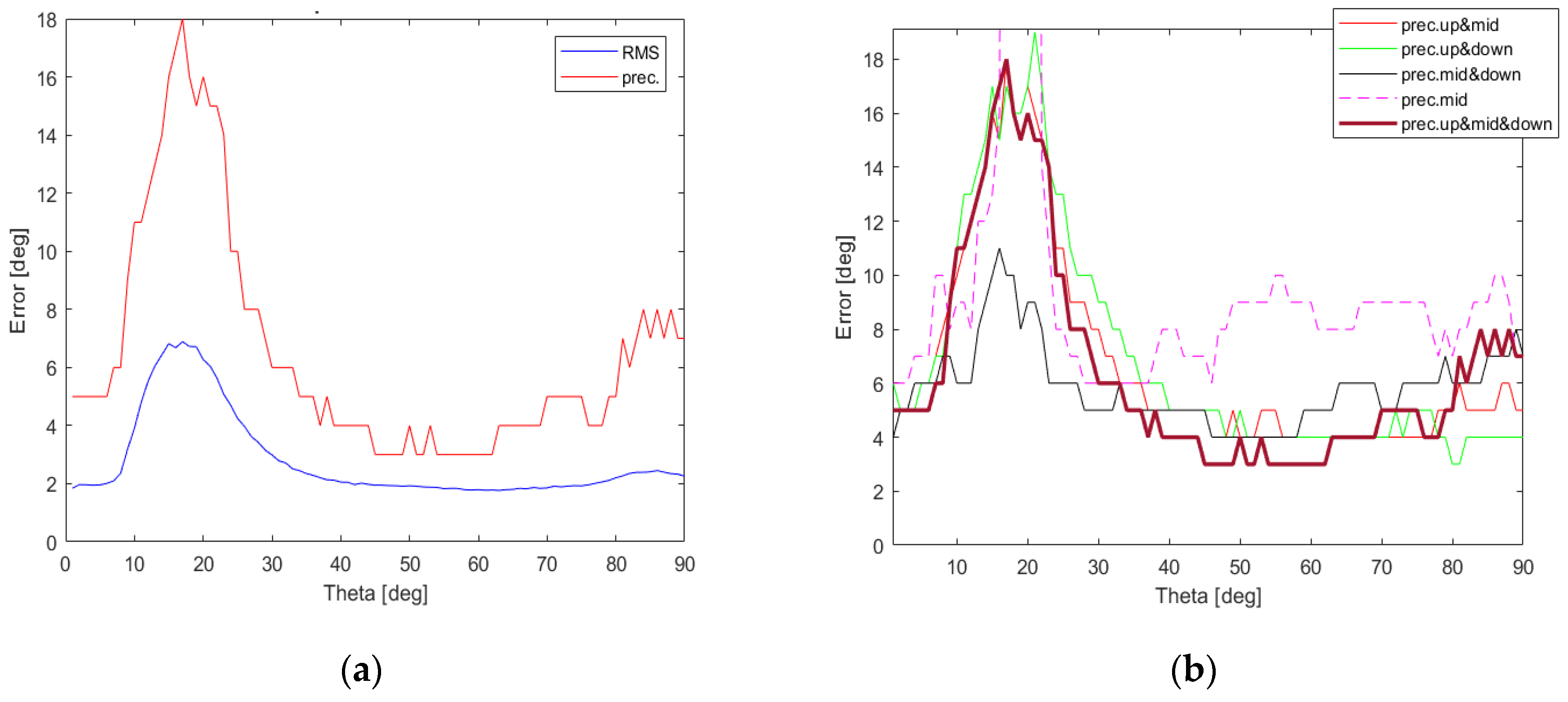
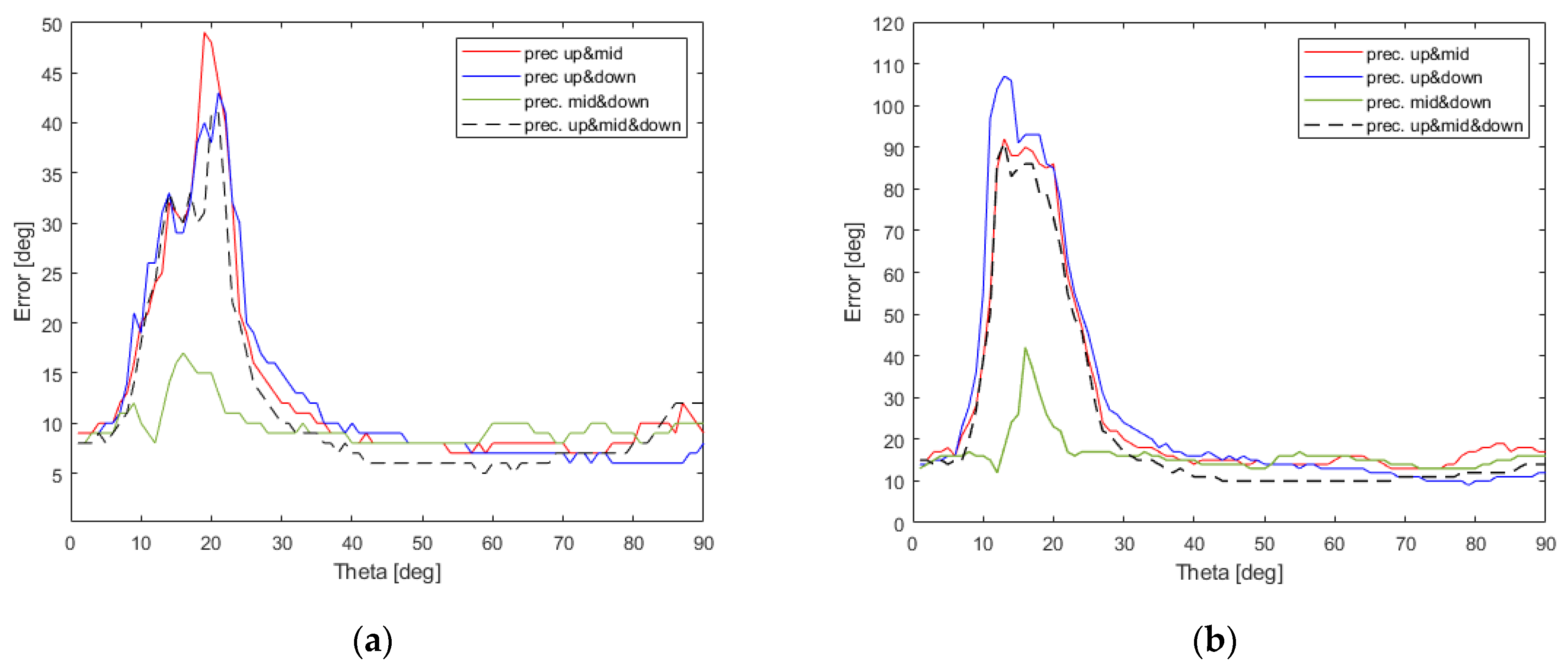
| Configuration | |S11| | ||||||
|---|---|---|---|---|---|---|---|
| UP | 46° | 7.7 dB | 45° | 88° | 10 dB | 14 dB | −20.9 dB |
| MID | 52° | 7.8 dB | 43° | 100° | 10 dB | 28 dB | −10.5 dB |
| DOWN | 56° | 8.1 dB | 46° | 93° | 12 dB | 25 dB | −8.8 dB |
| Steering Vector Short Name | ||||
|---|---|---|---|---|
| 1 | 30° | 46° | ||
| 2 | 90° | 46° | ||
| 3 | 150° | 46° | ||
| 4 | 210° | 46° | ||
| 5 | [ | 270° | 46° | |
| 6 | [ | 330° | 46° | |
| 7 | 30° | 56° | ||
| 8 | 90° | 56° | ||
| 9 | 150° | 56° | ||
| 10 | 210° | 56° | ||
| 11 | 270° | 56° | ||
| 12 | 330° | 56° | ||
| 13 | 30° | 52° | ||
| 14 | 90° | 52° | ||
| 15 | 150° | 52° | ||
| 16 | 210° | 52° | ||
| 17 | 270° | 52° | ||
| 18 | 330° | 52° |
| Combination of Steering Vector Sets | Steering Vectors Numbers | Total Number of Steering Vectors |
|---|---|---|
| 6 | ||
| 6 | ||
| 6 | ||
| 12 | ||
| 12 | ||
| 12 | ||
| 18 |
Publisher’s Note: MDPI stays neutral with regard to jurisdictional claims in published maps and institutional affiliations. |
© 2022 by the authors. Licensee MDPI, Basel, Switzerland. This article is an open access article distributed under the terms and conditions of the Creative Commons Attribution (CC BY) license (https://creativecommons.org/licenses/by/4.0/).
Share and Cite
Rzymowski, M.; Nyka, K.; Kulas, L. Direction of Arrival Estimation Based on Received Signal Strength Using Two-Row Electronically Steerable Parasitic Array Radiator Antenna. Sensors 2022, 22, 2034. https://doi.org/10.3390/s22052034
Rzymowski M, Nyka K, Kulas L. Direction of Arrival Estimation Based on Received Signal Strength Using Two-Row Electronically Steerable Parasitic Array Radiator Antenna. Sensors. 2022; 22(5):2034. https://doi.org/10.3390/s22052034
Chicago/Turabian StyleRzymowski, Mateusz, Krzysztof Nyka, and Lukasz Kulas. 2022. "Direction of Arrival Estimation Based on Received Signal Strength Using Two-Row Electronically Steerable Parasitic Array Radiator Antenna" Sensors 22, no. 5: 2034. https://doi.org/10.3390/s22052034
APA StyleRzymowski, M., Nyka, K., & Kulas, L. (2022). Direction of Arrival Estimation Based on Received Signal Strength Using Two-Row Electronically Steerable Parasitic Array Radiator Antenna. Sensors, 22(5), 2034. https://doi.org/10.3390/s22052034






